Hermit
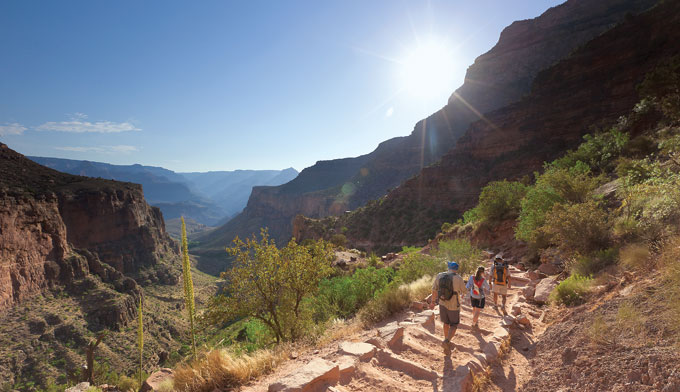
| Route 66 | Cities | Beaches |
|
Hermit |
 |
| Hiking | South Rim | West Rim | Boucher | Bright Angel | South Kaibab | Grandview |
| The Hermit Trail is the best kept secret at the Grand Canyon. It's way out there to the West. You can't drive to the trailhead and it's a nine mile hike, so the only real access is by the Hermit's Rest Shuttle (Red). Even most of the people who actually take the shuttle get off a few times to take pictures, stop for a drink or an ice cream at the Hermit's Rest Visitor Center, then get back on the bus and return to the village. But that's unfortunate, because this is a great trail. It's the remains of an old Anasazai and then Havasupai trail all the way down to the river. Prospector Dan Hogan (the "hermit") improved it in 1896 and used it for 10 years. The Santa Fe Railroad took it over in 1913 and built the steps as part of an elaborate resort camp they established down on the Tonto Plateau. As the National Park Service photo at right shows, they built this camp, which included tent cabins, a dining hall and horse stables, at the base of Cope Butte. Tonto Trail, which runs the entire length of the canyon along the Tonto Plateau, joins the Hermit Trail there. | 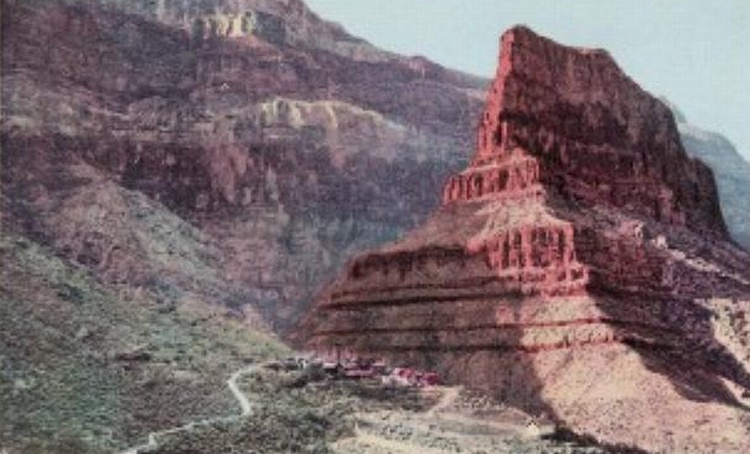 |
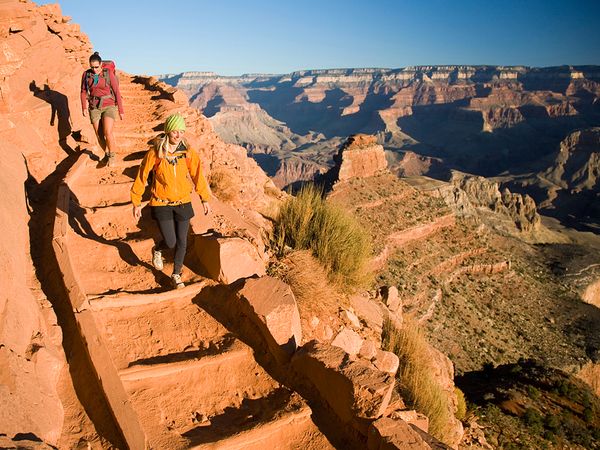 |
To begin the Hermit Trail, follow the dirt road 100 yards West of the bus stop. You'll first drop toward the southwest through a thousand feet of switchbacks, then intersect with the Waldron Trail (Horsethief Trail) as it comes in from Horsethief Tank. Turn right (west). In another 0.3 mile you'll intersect with the Dripping Springs Trail. Turn right again (north) and follow the cobblestone stairs down to Santa Maria Spring, where there's a rest house refurbished in 1989. Santa Maria is two miles down. At the four mile point you come to Four Mile Spring, which dries up in the Summer, and Lookout Point. This is a common turnaround point for dayhikers, and will give you an eight mile round trip. This brings you to Cathedral Stairs, one of the most breathtaking segments of any trail in the Grand Canyon. As you hike along here, if you look carefully, you can still see remnants of the old cable car the Santa Fe built from Pima Point down to the Cope Butte Resort. The camp burned in 1936. The park service has cleaned up most of the remains, but a few foundations and other relics remain, including the bases for the cable car. In the photo to the left, that's Cope Butte to the right of the hikers (and far below). |
| This is the horse trough and stone shelter house at Santa Maria Springs. The actual spring is on the other side of the shelter house. At this point you're two miles down, so if you turn around and hike back up you'll have a four mile round trip. This is a very common turning point for beginning hikers or for those pressed for time. The Hermit Trail is often more strenuous than Bright Angel or South Kaibab because rock slides and washouts have twisted, eroded or covered the original trailbed. You have to pick your way across the rubble to find the trail on the other side. This will slow you down and wear you out. |
| This is Breezy Point, so called because the wind is usually pretty stiff her, blowing up from below and quite warm. This is four miles down, and is the most common turnaround point for day hikers. Below this the trail enters a much steeper section, with stairs and switchbacks as it descends to the Tonto Plateau. In the Summer the section beyond Breezy Point becomes extremely hot, averaging about 100 degrees between 10 am and 4 pm. |
| However, if you insist on going on, from the bottom of Cathedral Stairs, you enter the drainage of Hermit Creek, which has carved a winding slot through the surrounding formations. From here on, you'll either be walking slightly above the creek or in a few places crossing it or even walking in it. You'll pass several side canyons which make interesting explorations and good photos. One problem with the Harmit Trail is that it is not as well maintained as Bright Angel and South Kaibab. The mule pack trains don't use it, and the heavy crowds of hikers and backpackers don't use it, so the park service doesn't consider it as high a priority. As a result, you may encounter rock slides and washouts left over from the previous Winter. These are not so serious as to prevent you from using the trail --- the park service does make sure it's safe --- but they may slow you down a bit. | 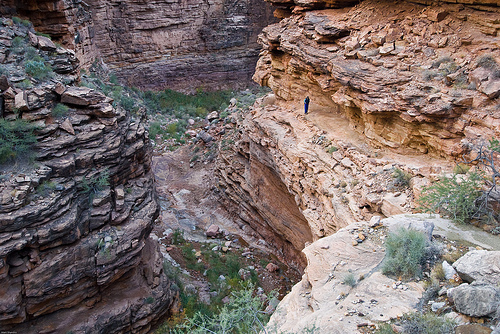 |
| On other pages we refer to the Hermit Trail as a backpacking route. The entire trail extends 8.5 miles down to the Colorado River. It's worth hiking on an overnight trip because it brings you to some of the most spectacular white water rafting rapids on the river, and you can sit there for hours watching rafters try to make the descents without capsizing. But it's too far for a one day round trip. You'll have to estimate your hiking capacity carefully. To Hermit Camp, at the base of Cope Butte where the old resort used to be, is six miles one way, meaning a 12 mile round trip. This is a possible day hike IF you're in top condition, but most people overestimate the condition they're in. We suggest you use a time standard. Get up early, have a good breakfast and ride the shuttle out to Hermit's Rest. Hit the trail at 9 a.m. and hike down until noon. Regardless of where you are, stop at noon for lunch, then start back. 90% of all hikers require twice as long ascending as descending. So however far you are down in the canyon, if you pause there for an hour's lunch break, it will take you until 7:00 p.m. to climb back out to Hermit's Rest. You can grab a snack at Hermit's Rest, then catch the shuttle back to the village for a full dinner. Most hikers will reach Hermit Camp in three hours. But the hikes down to Four Mile Spring or Breezy Point are still excellent day hikes, with great views and a satisfying challenge getting back up. |
| Like all the canyon's trails, the Hermit Trail is best hiked in April, May, October and November. The photo at right was taken in April. However, if your schedule dictates that you can only visit the canyon in June, July, August, or September, of all the trails, this is the best trail to hike. The water flows all Summer so you can dip your feet or soak a hat or bandanna frequently. There's more shade, particularly before 10 a.m. and after 3 p.m. And, while the Hermit's Creek Drainage is steep, it's not as thigh busting steep as Bright Angel or South Kaibab. You don't have the long switchback sections and the sustained uphills. It's also an advantage to have the Hermit's Rest Visitor Center at the trailhead, so immediately coming off the trail you can pause for a rest and refreshment. |
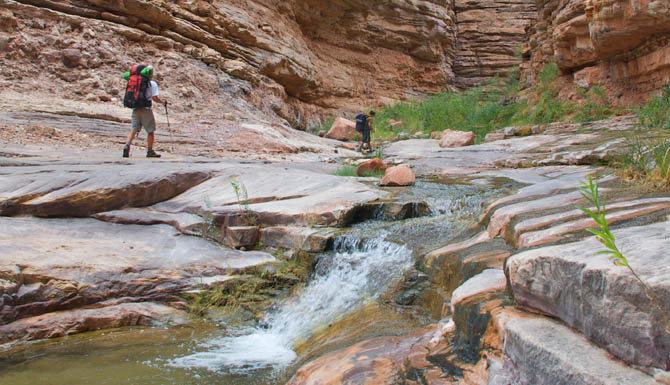 |
The water in Hermit's Creek, Santa Maria Spring and Four Mile Spring appears clean and clear, but is not safe. The headwaters are up on the Coconino Plateau, where there is plenty of wildlife, especially grazing animals. So the water contains giardia. You need to carry drinking water. The stream water is safe for dipping bandannas or dousing your face, however. It flows surprisingly cool during the hot Summer months. |
| Below the Cathedral Stairs, the trail intersects with The Tonto Trail coming in from Indian Gardens to the east. The two trails run together for one mile to the base of Cope Butte and the Hermit Campground. There are pit toilets at the campground but no drinkable water faucet. | 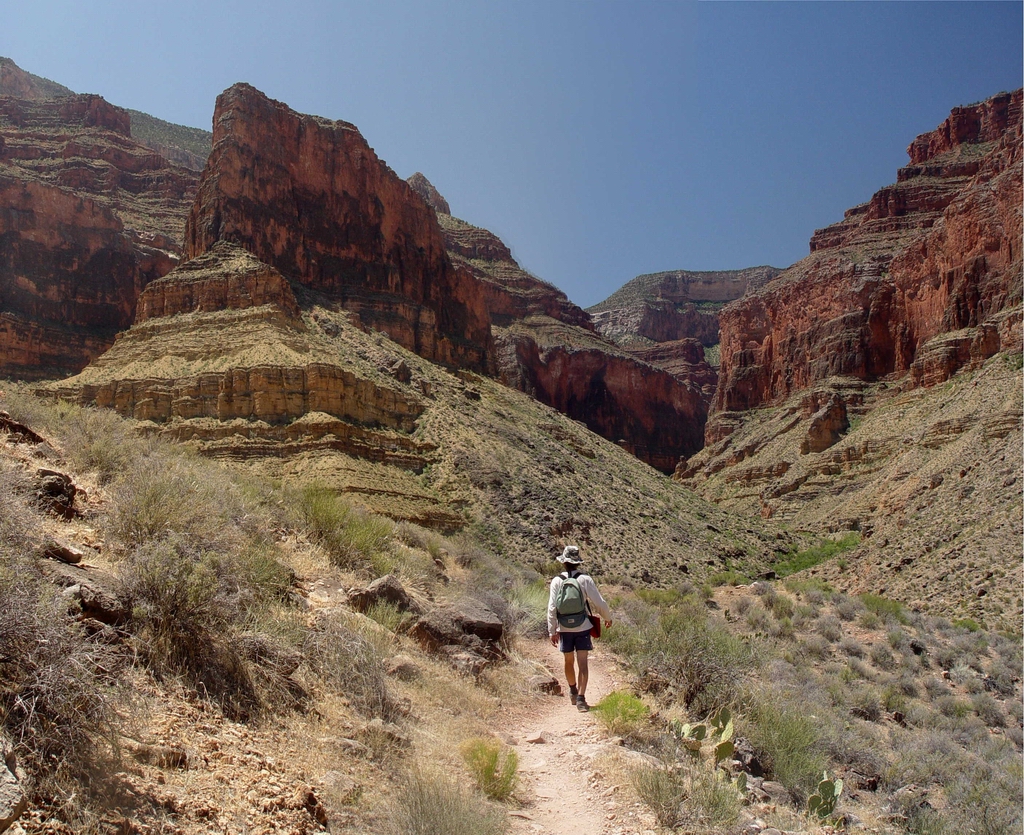 |
 |
If you're a strong enough hiker to make it down to Hermit Camp, during your one hour lunch break you can reward yourself with a dip in one of the many pools Hermit Creek forms as it descends toward the Colorado. The cool water is especially welcome in the Summer heat. |
|
|||
|